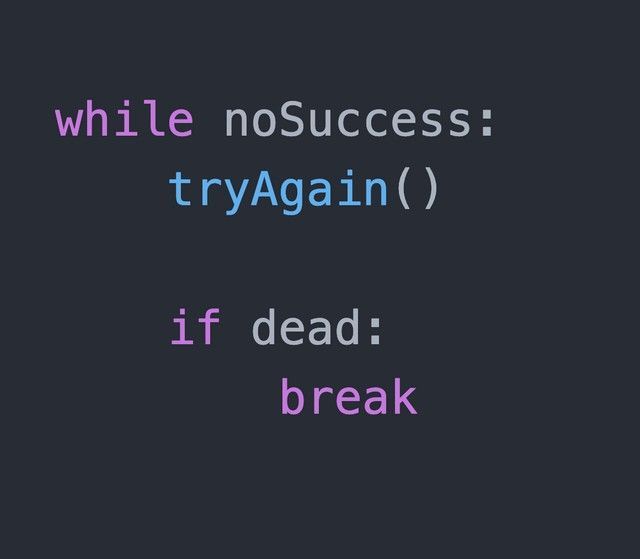Instruction Set(指令集)
The repertoire(全体) of instruction of a computer
Arithmetic Operations
- Add and subtract, three operands
- Two sources and one destination
add a, b, c // a gets b + c
- All arithmetic operations have this form
Register Operands
- Arithmetic instructions use register operands
- RISC-V has a 32 * 32-bit register file
- use for frequently accessed data
- 32-bit data is called a “word”
- 32 * 32-bit general purpose registers x0 to x31
- 64-bit data is called a “doubleword”
- 16-bit data is called a “halfword”
Immediate Operands
- Constant data specified in an instruction
addi x22, x22, 4 - Make the Common case fast
- small constants are common
- Immediate operand avoids a load instruction
立即操作数可以避免load指令操作
The Constant Zero
- RISC-V register x0 is the constant 0
- Cannot be overwritten
- Useful for common operatons
- E.g. negate a value in a register by sub zero by the value
使用该寄存器进行取反操作 sub x9, x0, x8
- E.g. negate a value in a register by sub zero by the value
RISC-V Registers
- x0: the constant value 0 (存常数0)
- x1: return address(返回地址)
- x2: stack pointer (栈指针)
- x3: global pointer(全局指针)
- x4: thread pointer
- x5 - x7, x28 - x31: temporaries(临时变量)
- x8: frame pointer (帧指针)
- x9, x18 - x27: saved registers(保存寄存器)
- x10 - x11: function arguments/results(函数返回值)
- x12 - x17: function arguments(函数参数)
Design Principle
- Simplicity favours regularity
简单源于规整 - Smaller is faster
小则快 - Good design demands good compromises
Endianness (端序)
小端字节序,高字节存放于内存高地址,低字节存于内存低地址,大端字节反之
Sign Extension
简单来说就是将一个数扩展到更高的位数,而为了保持本来这个数的值,则按照最高位向前扩展。
- Representing a number using more bits
- Preserve the numeric value
- Replicate the sign bit to the left
- c.f. unsigned values: extend with 0s
- e.g.
addi x11, x0, 0x8f5- Immediate is always sign-extended to 32-bits before use in an arithmetic operation
- Examples: 8-bit to 16-bit
- +2:0000 0010 => 0000 0000 0000 0010
- -2: 1111 1110=> 1111 1111 1111 1110
- In RISC-V instruction set
- lb: sign-extend loaded byte (符号扩展)
- lbu: zero-extend loaded byte (零扩展)
RISC-V Instruction Formats
#Instruction_Formats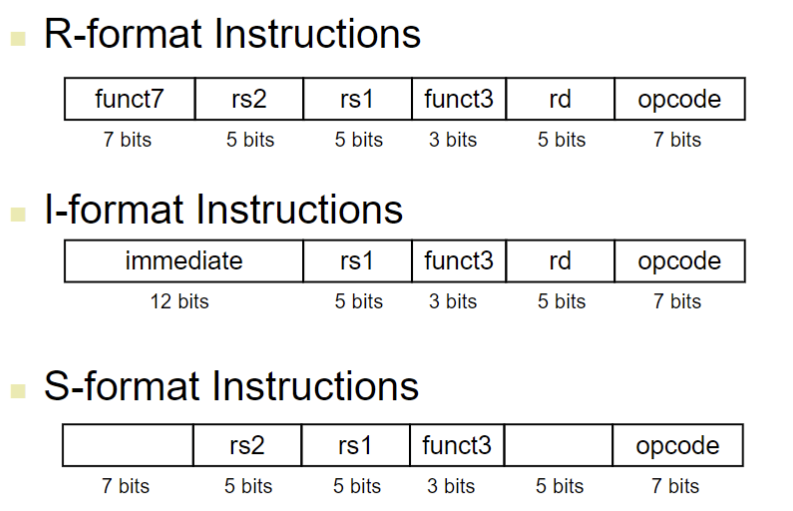
R-format
同时具有rs1,rs2,rd
#Instruction_Formats/R-format
- Instruction field
- opcode: operation code
- rd: destination register number
- funct3: 3-bit function code(additional opcode)
- rs1: first source register number
- rs2: second source register number
- funct7: 7-bit function code(additional opcode)
I-format
#Instruction_Formats/I-format
立即数为12位字段,即[11:0],同时注意符号位扩展,从12位扩展到32位
代表指令:addi,load,slli,slri,jalr
Immediate arithmetic and load instructions
- rs1: source or base address register number
- immediate: constant operand, or offset added to base address
addi x15, x1, -50
- Immediate is always sign-extended to 32-bits before use in an arithmetic operation
Load Instruction
lw x9, 240(x10)
- The 12-bit signed immediate is added to the base address in register rs1 to form the memory address(由rs1作为基地址,然后加上立即数进行跳转)
- This is very similar to add-immediate operation but used to create address not to create final result
- The value loaded from memory is stored in register rd
S-format
#Instruction_Formats/S-format
有rs1, rs2,rd变为立即数的[4:0]字段,立即数仍然为12位[11:0],但是是隔断的
代表指令:store
- rs1: base address register number(基地址寄存器,根据这个里面的地址再加上立即数进行跳转)
- rs2: source operand register number
- immediate: offset added to base address
- Split so that rs1 and rs2 field always in the same place
- ![[Chapter_2 Instructions in different format#Design Principle]]
- Split so that rs1 and rs2 field always in the same place
U-format
#Instruction_Formats/U-format
没有rs1, rs2,只有rd,也没有func字段,立即数为20位[31:12](低位字段清零),(常与addi连用,注意符号位扩展)
代表指令:lui

32-bit Constants (大立即数)
- For the occasional 32-bit constant
lui rd, constant- Copies 20-bit constant to bits [31:12] of rd
- Clear bits [11:0] of rd to 0
U-format for “Upper Immediate” instructions
- Has 20-bit immediate in upper 20 bits of 32-bit instruction word
- One destination resgister, rd
- Used for two instructions
- LUI - Load Upper Immediate
- AUIPC - Add Upper Immediate to PC
- LUI to create long immediates
- LUI Copies 20-bit constant to bits[31:12] of rd, Clear bits [11:0] of rd to 0.(高20位加载,低12位置0)
- Together with an
addito set low 12 bits, can create any 32-bit value in a register using two instructions (lui, addi)(使用lui和addi两条指令来构建一个完整的加载大立即数的操作)
#Create_long_immediates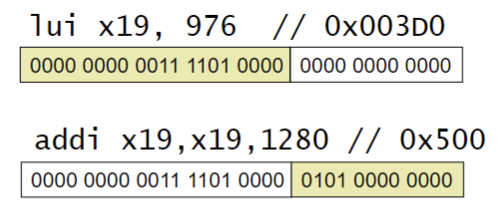
思考:如何得到0xDEADBEEF ?
错误解答(简单的拼接):
1 | lui x10, 0xDEADB # x10 = 0xDEADB000 |
Point:
addi 12-bit immediate is always sign-extended, if top bit is set, will subtract -1 from upper 20 bits
一定要注意低12位的符号位,addi指令总是进行符号扩展,如果符号位为1,会从高20位中减去1
正确解答:
1 | lui x10, 0xDEADC |
SB-format
有rs1, rs2 (进行算术运算),没有rd,12位立即数字段被分为[12],[10:5],[4:1],[11],所以立即数为[12:1],以半字为单位,这点要非常注意
代表指令:beq
- Branch instructions specify
- Opcode, two registers, target address
- Most branch targets are near branch
- Forward or backward
- SB format, mostly same as S-format
#Instruction_Formats/SB-format
- But now immediate represents values -4096 to +4094 in 2-byte increments
- The 12 immediate bits encode even 13-bit signed byte offsets(lowest bit of offset is always zero, so no need to store it)
#Instruction_Formats/SB-format/Branch_Example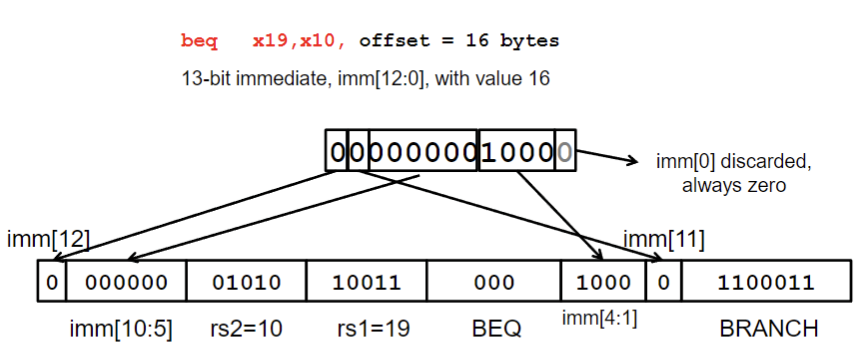
UJ-format
#Instruction_Formats/R-format/UJ-format
有rd,没有rs1, rs2,立即数字段被拆分为[20],[10:1],[11],[19:12],主要用于跳转到指定地址。(注意也是半字为单位)可以向前后各跳转2^18个指令
如果要进行大范围跳转,那使用lui和jalr的组合指令(注意jalr就不是半字为单位了)
代表指令:jal
jaltarget uses 20-bit immediate for larger range- For long jumps, eg, to 32-bit absolute address
lui: load address [31:12] to temp registerjalr: add address [11:0] and jump to target
Uses ofjal:
- j pseudo-instruction
j Label = jal x0, Lable #Discard return address
- Call function within +-2^18 instructions of PC
jal ra, FuncNamejal的imm是2^(20+1)个byte- 由于一个指令对应4个byte,所以2^19对应+-2^18条指令
jal 与 jalr 对比
- jal为UJ-format
- jalr为I-format
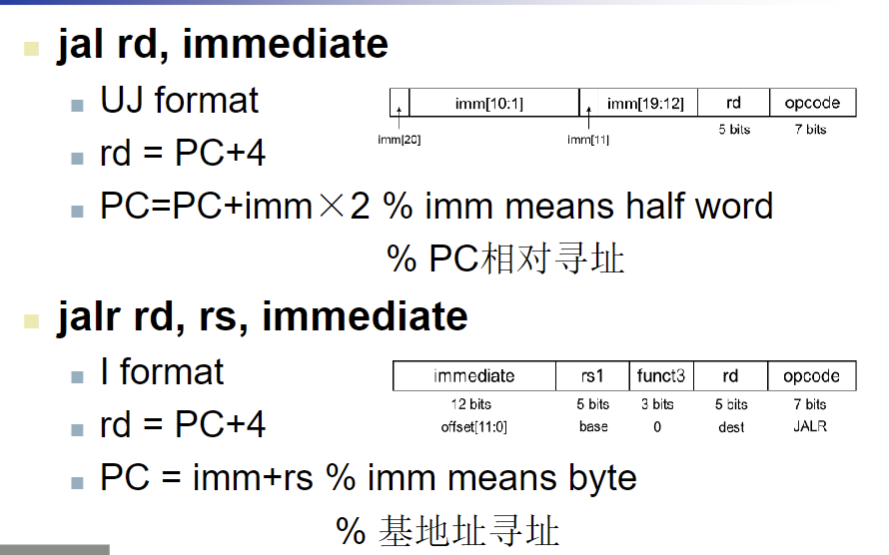
四种不同的寻址方式
- 立即数寻址
- 寄存器寻址
- 基地址寻址
- PC相对寻址
- beq,bne,jal
过程调用的步骤
- 将参数放到x10 - x17
- 交换过程的控制权
- 为过程分配存储空间
- 执行过程操作
- 将结果放到寄存器中给调用者
- 回到 x1 中的保存地址
#logic_operation/and
AND Operation
- 选择性置零
- and 0
#logic_operation/or
OR Operation
- 选择性置1
- or 1
#logic_operation/xor
XOR Operation
- 选择性翻转
- xor 1
边界检查
#边界检查
- 当使用角标大于等于数组长度或为负数发生数组下标越界
- 将有符号数当作无符号数处理
- 最高有效位在有符号数中表示符号位,在无符号数中表示数的很大一部分
- 无符号比较在检测x<y时,也检测了x是否为负数
- bgeu x, y, IndexOutofBounds
- case 1: x >= y (索引号>数组长度)
- case 2: x < 0(索引号为负)
The “ABI”(Application Binary Interface)
A contract between functions
Caller-saved register and Callee-saved register
The difference between two strategies
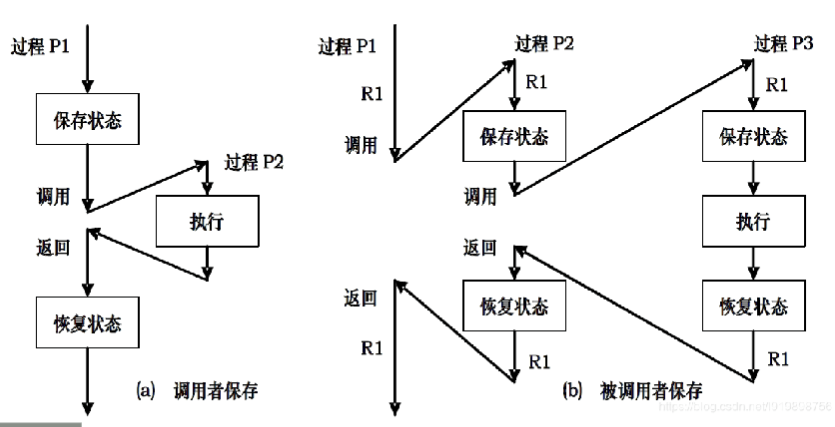
The RISC-V Register and Convention
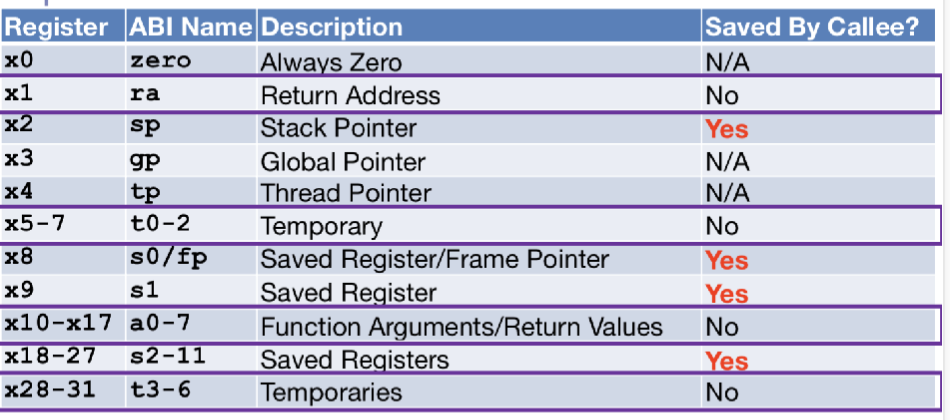
To Summerize:
caller 保护:
- x1 返回地址
- x10 - x17 参数
- x5 - x7, x28 - x31 临时变量
why identify the caller/callee saved
example:
1 | int a, b, c, d; |
对于上面的例子,a,b,c,d 是声明出来的变量(存储在r0 - r3中),而在计算a 的值的时候,无法通过一条指令完成,需要借助临时变量,比如tmp(分配t0寄存器)
首先计算 tmp = b - csub r1, r2, t0
然后计算a = tmp + dadd t0, r3, r0
tmp的生命周期到此为止,它的生命周期非常短,但又有专门的寄存器来保存这个临时变量,这种寄存器里面的值总是易变的,用完即废
所以在函数调用过程中,对于两类寄存器有着不同的责任保护方,第一类寄存器(r)如果在callee里面改了,不做保护的话,caller里面声明的变量值都改变了,这类寄存器,callee用了一个就要保护一个;
对于第二类寄存器(t),临时变量用完即废,callee破坏了也可能没啥影响,callee没有义务保护,但如果caller确实希望保存该临时变量,也必须由caller声明进行保护。
Change 64-bit to 32-bit
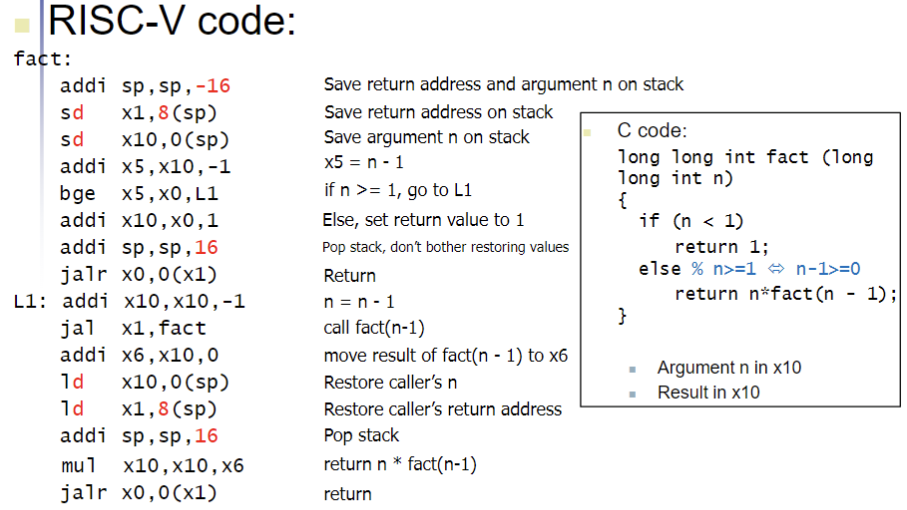
cut all the labeled red half:
- doubleword to word
- 16 to 8
- 8 to 4



